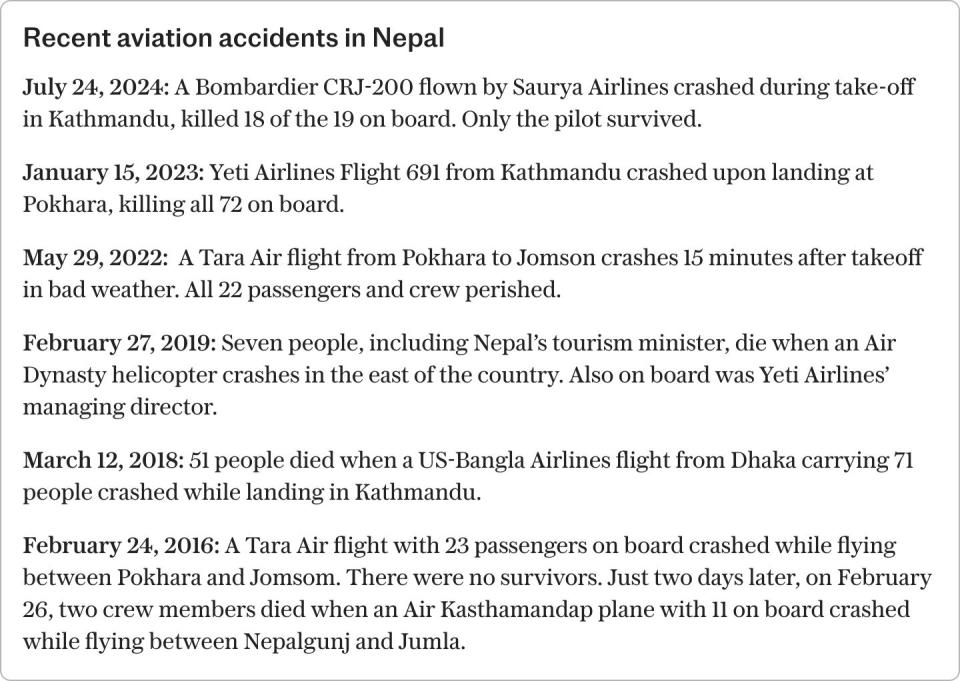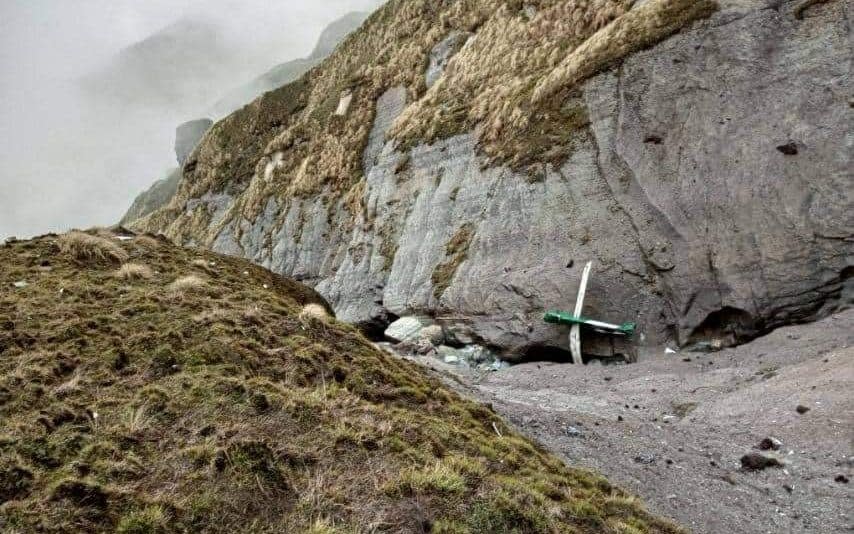At least 18 people were killed when a small plane crashed and caught fire during takeoff from Nepal’s capital Kathmandu.
Nepal Police spokesman Dan Bahadur Karki said the Saurya Airlines plane was carrying two crew members and 17 staff of the company.
The crash raises new concerns about the safety of Nepal’s skies. The country has seen 19 fatal aviation accidents since the turn of the century, with a total of 359 fatalities. Today’s crash follows the January 2023 crash of Yeti Airlines Flight 691, Nepal’s deadliest in 30 years.
All Nepalese airlines have been banned from European airspace since 2013 because of their poor safety record. Aviation regulators say there have been some improvements in recent years but the problems persist.
Here, we look at why Nepal remains one of the world’s most dangerous places to fly, and ask what travellers considering travelling there can do to minimise their risk.
What caused the recent collapse?
The causes of the latest crash are not yet clear, but more details are likely to emerge in the coming days.
The Nepalese military said in a statement that the plane crashed at around 11:15 am (05:30 GMT). News website Khabarhub reported that the plane burst into flames after skidding off the runway.
The plane was scheduled to fly on Nepal’s busiest air route between Kathmandu and Pokhara, a major tourist destination in the Himalayan republic. Saurya Airlines flies only Bombardier CRJ200s, according to its website. The crash left the fleet with just one aircraft.
Does Nepal experience more accidents than other countries?
Yes. The crash is Nepal’s 12th fatal plane crash in the past two years — a remarkable statistic considering its relatively modest flight schedule.
While there is no definitive global reference for aviation safety on a country-by-country basis, by most measures Nepal is one of the world’s most dangerous places to fly.
As mentioned above, since 2013 all Nepalese airlines have been banned from European airspace due to their poor safety record.
The International Civil Aviation Organization’s 2022 audit of aviation safety found that the level of implementation of certain elements of safety management in Nepal remains below the global average.
AirlineRatings.com ranked Nepal Airlines among the 14 worst airlines for safety, along with carriers from Iran and Suriname, with just one star.

What are the reasons for Nepal’s poor security record?
Nepal’s alarming record is due to a combination of factors. AirlineRatings.com Editor-in-Chief Geoffrey Thomas lists three main reasons: “Hazardous flying conditions in and around the Himalayas”, sometimes “substandard pilot training and therefore skills”, and “poor and dangerous airports, often below world standards due to the mountainous terrain”.
The country is home to many of the world’s highest mountains, making it uniquely dangerous for pilots who must navigate both the peaks and the rapidly changing weather conditions. In 2015, the United Nations’ International Civil Aviation Organization prioritized the country for technical assistance, stating then that “its beautiful but rugged terrain makes the safety of air operations more challenging than in other parts of the world.”
Mountainous airports tend to have shorter runways, requiring greater piloting skills and can only accommodate smaller, sometimes less reliable aircraft. Nepal’s Lukla Airport, the gateway to the Everest region, was previously named the world’s most dangerous—an unwelcome but not surprising title given its accident rate. The airport’s runway is just 1,729 feet long (Heathrow’s shortest is 12,008 feet) and ends abruptly at a brick wall. With mountains rising on all sides, there’s little opportunity for an aborted landing, so pilots have to get it right the first time. The airport’s altitude also means the air is thinner, so planes have no choice but to arrive faster.
With Nepal remaining one of the poorest countries in Asia, it’s no surprise that some airlines have aging fleets and pilot training programs that can’t compete with those of Western countries. Industry insiders have observed that some older aircraft don’t even have GPS systems. Yet according to the website Planespotters.net, the Saurya Airlines Bombardier CRJ200 (registration 9N-AME) involved in the latest crash was 21 years old — a fairly typical age for a commercial airliner. The Yeti Airlines plane involved in the 2023 crash was just 15 years old.
Some think Nepalese authorities could do more to improve safety in the skies. After a 2022 crash involving Tara Air, Ashok Pokharel, president of the Nepal Tour Operators Association, told the Guardian: “Older aircraft do not have modern weather radars. This could be made mandatory so that the captain has real-time weather information for the place he is flying.”


What can travelers do to reduce their risks?
Those planning a trip to Everest or trekking in the Himalayas may be apprehensive about booking domestic flights in the country as it is hard to avoid given the poor condition of the country’s roads.
The Foreign Office (FCDO) travel advice page for Nepal states: “Air accidents can have a variety of causes and are not necessarily linked to poor safety standards or non-compliance with international safety standards. However, there have been a number of fatal accidents and air crashes in the commercial air transport sector (involving aircraft and helicopters) across Nepal. Over the past five years, this has included a number of isolated incidents and at least 100 deaths.
It adds: “The UK Air Safety List (ASL) lists all known airlines in Nepal that do not meet international safety standards and are banned from operating commercial air services to or from the UK. Check the UK Air Safety List when considering whether to fly and which airlines to fly with. The list is maintained by the Department for Transport based on advice from the UK Civil Aviation Authority.
“Currently, no Nepalese airlines meet international safety standards and therefore they are all listed on ASL. This means they are all prohibited from operating commercial air services to or from the UK.”
As a result, tourists embarking on a journey may need to assess their own appetite for risk. As Geoffrey Thomas puts it: “There are very few options for backpackers and adventure tourists. Climbing Everest is dangerous, and so is flying there.”
This article was originally published in January 2023 and has been revised and updated.